Back to page 1
The Design
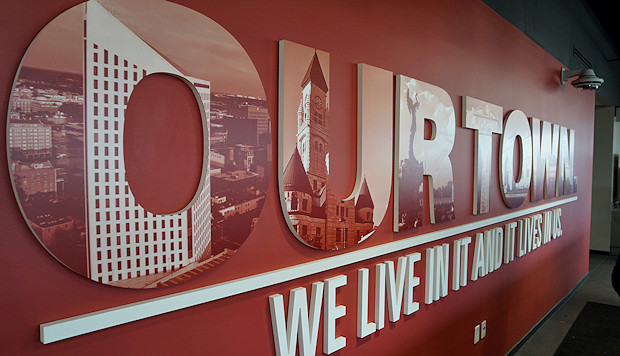
This is a good time to describe how the park currently known as Riverfront Stadium was designed and built.
First, the architects at DLR Group in Kansas City generated some design ideas for Schwechheimer prior to the firm commitment by Wichita to build the stadium. When the project received the green light, the city had a problem: the desired opening date of April 2020 was only a year and a half away. A project of this magnitude usually takes a full two years to design and build.
“Design” and “build.” Those became the two most important words in this process, because this became a “design build project.” This means that a team of designers and builders closely coordinate the work, with construction occurring long before the whole stadium has been designed.
The operative phrase became “just in time.” The designers would deliver the plans for the next part of the ballpark just as the construction ended on the previous section. That’s how the park was built – with the design for each section being finalized just before it was constructed.
The city released an RFP for the ballpark, inviting “teams” to pitch their ability to work together. It’s pretty common for a team to consist of a national sports architecture firm, a local architect, a national construction company and a local construction firm – and perhaps an outfit to coordinate the engineering. The “team” that won the bid in December 2018 to carry out this design-build project consisted of DLR Group, SJCF, JE Dunn Construction, EBY Construction and Professional Engineering Consultants. When the construction meetings commenced, there would also be representatives from the city and the team.
So that’s how Riverfront Stadium was designed and built in a very tight 15-month timeline.
 |
| In one of the suites is this tribute to the five companies that made up the design-build team that created Riverfront Stadium. |
But there’s another huge factor to take into account: when all of the designing and all of the building was going on, everyone assumed this was going to be a ballpark for a Triple-A team, with all of the Triple-A requirements for seating capacity, lighting, clubhouse space, etc.
The stadium was done on time (actually a year early, considering that there was no season in 2020) … and you can really tell that this was designed for Triple-A. It has a much larger feel than, say, the Rocket City Trash Pandas’ Toyota Field, which was always intended to be a Double-A ballpark.
Triple-A parks can usually hold about 10,000 fans. “We wanted a capacity of 10,000, but only about 6,500 to 7,000 fixed seats because fans like to get up and move around,” says Carlson. “We wanted the 10,000 to feel comfortable. And what we’re seeing now are fans hanging out at drink rails, looking out at the field.
“And we were super-conscious about the concourse width. We want people to be able to move around.”
With the extra seating capacity and all of the wide-open spaces, the main thing that Wichita’s park lacks that Toyota Field has in abundance is intimacy. Adding to the lack of intimacy is the fact that the rows of seats run almost exactly parallel to the foul lines, with only a very slight bend, nearly all the way down to the foul poles. In other new parks like Kannapolis, Gastonia and Rocket City (Madison, Alabama), there are sharp angles in the seating sections that curve the rows down the foul lines toward the infield. In those parks, it feels like the seating bowl embraces the infield, adding an element of intimacy.
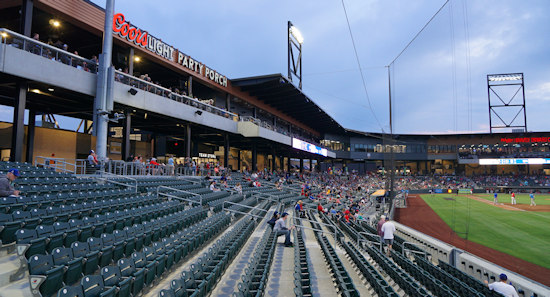
To be fair, the designers did give some thought to implementing sharper angles. Says Tingle, “We thought about changing the geometry, but were concerned about the loss of seating, poor sight lines into the RF and LF corners and the impact on the soccer and football layout.”
There are also no special areas adjacent to the backstop for super premium seats or concrete platforms for those in wheelchairs, nor are there anything like “dugout suites” or “concourse suites” (but there are “loge” boxes that protrude into the back rows). Just lots of straight rows of seats without much to break them up – although the legroom in the rows is wonderful. Just not much in the way of intimacy.
But keep this in mind: there are all of the open spaces at Riverfront Stadium that will one day be restaurants and hotels. Once those are built, it’s likely the park will feel more intimate.
Let’s look more closely at the main design elements at Wichita’s park, starting with an unusual decision. The designers and team took the unorthodox approach of constructing a separate building in right field to house the Wind Surge’s offices as well a large merchandise store, ticket operations, an upper level party deck and the space for a baseball museum one day. There’s even a radio/recording studio on street level where podcasts or pregame shows can be done.
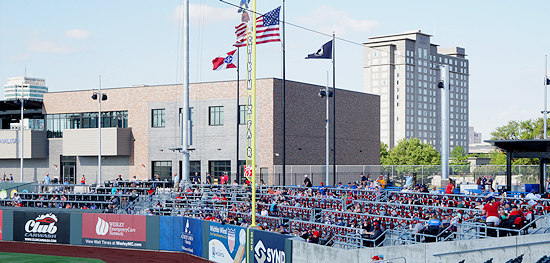 |
| A lot to look at here. In the right part of the foreground is Dillon’s Picnic Patio, and to the left of that is the Boot Barn Home Run Deck. The two story building — which is really three stories because the street beyond is one level down — holds the team offices and, one day, a baseball museum. The tall structure looming in the background is the Hyatt Regency Wichita, which is actually on the far side of the Arkansas River. |
“While other parts of the park are more fan-focused, Lou wanted his building to be in the middle of where all of his development was going to be,” says Tingle.
The main structure behind the seating bowl has two levels, as the very-wide main concourse is essentially underneath the suites and pressbox of the upper level. Like at Madison, there is a large opening directly behind home plate, all the better to allow air flow. In Wichita, there is somewhat of a food court created by the opening, meaning there are walls surrounding a little plaza there, while at Madison, that opening is open all the way to the street outside.
The upper level is one of the real strengths of Riverfront Stadium. On the third-base end, there is a huge, beautiful lounge for which Fidelity Bank is the naming sponsor (photo below). It also has tiered seats facing the field.
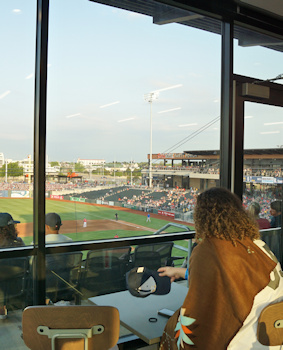 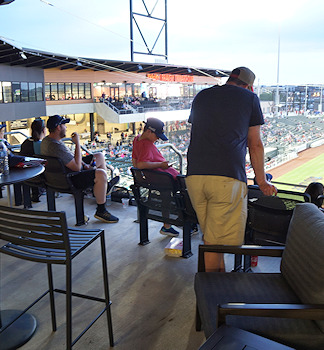 |
The luxury suites are beautiful, and combine the best of both worlds on their exterior: both a flat patio and tiered seats on the field side (photo above). This is the first time I’ve seen this combination in a park, as usually the suites either have only a flat patio (like Amarillo and Madison) or tiered seats – but not both. This is the perfect example of the spaciousness of Riverfront Stadium.
The pressbox is also roomy and is positioned where it should be — directly behind home plate on the upper level. Without a doubt, it is the best pressbox at any new ballpark this year – and that includes the Rangers’ $1.2 billion park in Arlington.
The Coors Light Party Porch (photo below) is a covered, open-air group area at the right-field end of the upper deck — although it’s too bad a light standard blocks your view somewhat. Such decks are all the rage in new-ballpark design, usually at each end of the upper level (examples include Las Vegas, Gastonia, Kannapolis, Madison, Fredericksburg, etc.). So why isn’t there a party deck at the end of the upper level on the third-base side? Kobritz has a good explanation for that.
He notes four key features of the ballpark that exceeded their original budget. In all cases, the additional expenditure was to benefit the fan’s experience at the park. Those four are: a bigger scoreboard; wider, more comfortable seats; upgraded technology (Wi-Fi and such); and larger restrooms. So the natural question is this: It’s been said over and over that Riverfront Stadium came in “on time and on budget.” How was that possible with cost overruns on those four features?
“There was a lot of horse-trading,” he replied with a laugh. “If you want this, you have to give up something. So one thing we decided to cut was the party deck on the third-base side.” It can be added later, though.
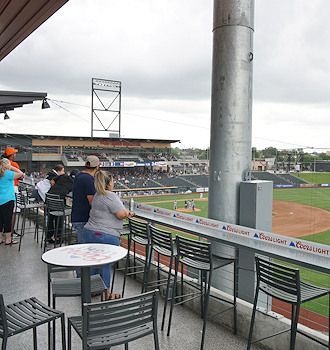 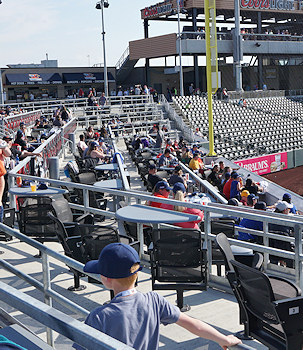 |
Another cut was a concession stand in left field, behind the berms. Folks there have to walk a little farther to reach concessions, although there is a clever bar in left field that was built in a cost-effective way.
A big hit among ticket-buyers has been the Dillons Picnic Patio that wraps around the right-field foul pole (photo above). It can hold up to 400 fans. Here you are facing the infield and can dine at four-top tables or larger picnic tables. Your food and beverage is included in your ticket price, with the buffet behind you under a canopy.
And in yet another comparison to the Rocket City Double-A park, the outfield dimensions are very smooth and consistent here, in stark contrast to Toyota Field’s walls which jut in and out in all kinds of crazy ways.
One constant at Riverfront Stadium is that you never feel cramped. You might go so far as to say the ballpark is a little overbuilt, especially for Double-A baseball. But who’s to say that a Triple-A team might not be playing here one day?
The Essentials
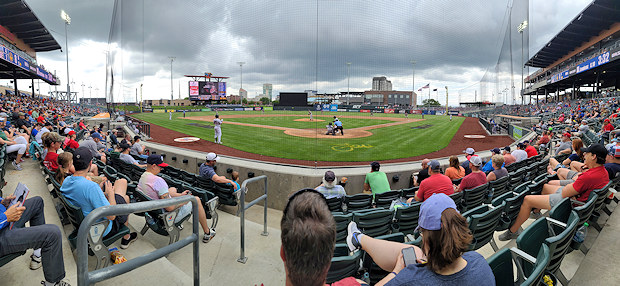
The spaciousness of the ballpark is certainly one of its appealing aspects. But what is it like to attend a Wind Surge game?
First things first: this is a cashless park. Be prepared to pay for everything via credit or debit card. That’s clearly the trend these days.
We’ve established that parking is somewhat limited adjacent to the ballpark. When Lawrence-Dumont was still standing, there were fairly large parking lots behind the third-base side of the park, but Riverfront Stadium’s footprint is much larger, plus space was allowed for the development that will occur beyond the park’s outfield. So the former lots are gone now.
The team does operate a lot across Sycamore Street, not far from the Delano Entrance. They charge $5 to park there. There is a private lot between a church and the park’s left field, and they also charge $5.
And keep in mind there is no shortage of parking lots and garages on the downtown side of the river, a couple of which offer free parking. It will take you about 10 minutes to walk to the stadium. On select dates, there’s also a shuttle to carry fans from the other side of the river to the park.
The cost of tickets is very straightforward, and its simplicity is much appreciated. All – and I do mean all – of the seats in the main seating bowl cost $15 if you buy them in advance. If you buy them on the day of the game, they cost $19, but you are given back a $3 credit that you can use at the store or a concession stand on that date. A general admission ticket for an adult is $10 and for children 12 and under, they are $8.
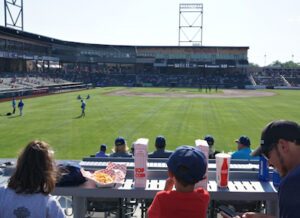 There is an interesting section of mesh seats with lots of legroom and countertops in right field. It’s called the Boot Barn Home Run Deck (see photo). Aside from the fact that you’re looking into the sun as it sets, this is really a premium section. Tickets here are $20.
There is an interesting section of mesh seats with lots of legroom and countertops in right field. It’s called the Boot Barn Home Run Deck (see photo). Aside from the fact that you’re looking into the sun as it sets, this is really a premium section. Tickets here are $20.
Groups with at least 25 members have lots of options, including Dillon’s Picnic Patio in the right-field corner for $35, the Party Porch for $42, and the Emprise Bank Pavilion (the upper level of the right-field building) for $48. All of these include a buffet. Groups can also buy blocks of seats in the main seating bowl at a savings.
There are two merchandise stores. An auxiliary store is on the main concourse behind first base, while the much-larger store is in right-center field. I was pleased with the prices I saw, and the variety was solid.
There were a number of attractive polos for men. Ones by Antigua were $48 to $62, and by Nike $45 to $74. Adult t-shirts were $22-$30. A nice jersey top was $70.
For women, Antigua tops were $38-$55.
Men’s adjustable caps were $24 and $30, and fitted caps were $30 and $35. There was even a version of a Wind Surge cap in distinctly Wichita State colors – which I think would be visible from a mile or two away. Caps designed for women were $24 and $30, while kids caps were $16-$20. T’s for kids, meanwhile, were $15-$31. A jersey top for a youngster was $60.
 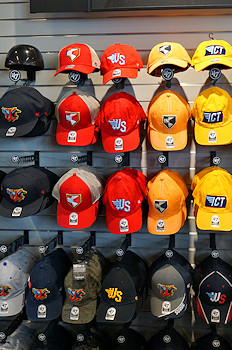 |
And of great importance to me (because I collect them) were lapel pins – which were absent from Madison when I was there three days earlier. The Wind Surge offered four types of pin, all priced at a very reasonable $5.
I thought the sound system was perfect and the video board in left field was large and very bright. However, I thought all of those square feet of high-res video weren’t used to their full advantage. Far more game info is communicated on a similar size board in Madison than at Riverfront Stadium.
I want to talk about the concessions and the gameday presentation together, because they mirror each other. By that, I mean that both offer very standard fare: nothing outlandish or particularly memorable. The approach to on-field entertainment and between-innings contests is professional and, if anything, low-key — but dare I say that an element of fun is lacking. The food selections can be described in similar terms.
To be fair, this approach to entertainment and food might be appropriate for the Wichita market. It’s just that other Minor League teams try to be more offbeat, memorable and, well, fun.
But none of them have as much art as at Riverfront Stadium!
At concession stands on both the first-base and third-base sides, they offer “Ballpark Favorites:” a hot dog for a reasonable $3.75; a jumbo dog for $5.25; a “loaded” dog (chili and cheese) for $7.75; and burgers, Italian sausage, tenders … and, interestingly, a veggie burger ($9.75) and a garden salad ($8.50).
During my visit, I tried a pulled-pork sandwich ($8) – which was so-so – and their standard hot dog, which was fantastic. One of the better hot dogs I’ve tasted. And unlike in Madison, I thought the buns on the two items were outstanding.
 But the concession spot that really has people talking – and lining up to eat their food and treats – is the Freddy’s stand directly behind home plate. Kobritz tells the story that they first noticed all of the construction workers were eating Freddy’s for lunch. Freddy’s national headquarters are in Wichita, so Kobritz says he approached them about opening a stand at Riverfront Stadium. At first they declined but promised to be a sponsor, then later changed their minds and agreed to have their first franchise inside a ballpark.
But the concession spot that really has people talking – and lining up to eat their food and treats – is the Freddy’s stand directly behind home plate. Kobritz tells the story that they first noticed all of the construction workers were eating Freddy’s for lunch. Freddy’s national headquarters are in Wichita, so Kobritz says he approached them about opening a stand at Riverfront Stadium. At first they declined but promised to be a sponsor, then later changed their minds and agreed to have their first franchise inside a ballpark.
It was tricky working their stand into a structure that had pretty much been completed, but the design/construction team made it happen. “It was important because we were sending a message to the people of the community that we care about what they want,” he adds.
The stand features their signature steakburgers with shoestring fries (although at a price a little higher than at their restaurants), at $10.50 for a combo without cheese on the burger and $11 with. Thankfully, they also have their frozen custard, but not in as many variations as at their stores.
To locals and out-of-towners alike, the Freddy’s stand is a welcome sight.
If what you’re looking for is something outlandish, zany, or insanely fun, you won’t find that here. But if you’re looking for an incredibly comfortable place to watch a game … at a reasonable cost … with a gameday presentation that doesn’t scream at you for nine innings, you’ve found your happy place. And perhaps the fans of Wichita have found their place … as long as the team wins more than it loses!
Summary

Before visiting the ballpark, I’d made a mental note to see if Schwechheimer was honored in any way. After all, it was his vision that brought this facility across the finish line.
I needn’t have worried. Lou is everywhere. A patch with his image is on the players’ jerseys. That image is on the facing of the upper deck behind home plate (photo in the Ballpark Stats box on the first page of this review). For some games, the letters L-O-U are mowed into the outfield grass, and for others, they are spray-painted on the grass in front of the backstop (photo below).
| Lou |
 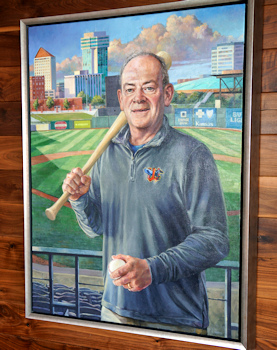 |
And there is a handsome painting of him hanging in the reception area of the team offices (photo above).
Every time I saw his name or image at Riverfront Stadium, it made me smile. I’m very glad he is being remembered and honored.
Kobritz tells the story of how Schwechheimer used to ask him over and over, “Do you think this is the best facility in Minor League Baseball?” Kobritz says that he always told Lou that the park is really good, and that it has a lot going for it, but he doesn’t know if it’s the best anywhere.
Lou would shoot back with “Well, is it in the top five?!?”
“You know, you can sit through 16 months of design meetings and construction sessions, and think you have an idea about how a ballpark will turn out, but you don’t really know until you see 7,500 people come through the gates and interact with it,” Kobritz says.
“Now that we’re here, I think we check every box, thanks to the designers and the construction team. As Lou always used to say, we came in on time and on budget.”
But not without overcoming adversities that no team should have to face.
Tell us what you think of this review or of Riverfront Stadium in the comments box below.
Many thanks for the wonderful insight on Riverfront Stadium in Wichita! I literally grew up in ‘iconic’ Lawrence-Dumont Stadium from the 50s to early 70s, serving as a batboy at MANY state and national semi-pro games in the 60s.
Tears came to my eyes while reading your report. Thank you for capturing the essence of Wichita, the immediate impact of late Lou and, the work his team is already doing within the community.
After living away from Wichita now for over 40 years, in a competing AA market, your report truly reinforced my passion for minor league baseball and its impact in local communities, especially when focusing on issues that make a difference for all…
I appreciate your kind remarks. I felt there was quite a story to tell about Wichita and its new ballpark, so thank you for taking the time to read it.
Thank you for a great review!
Great article and I did learn a few things I was not aware of; like the subtle art in the fencing. I have to go in another way next time to find all the things you pointed out I did not know about. A couple of things the article did not point out that I think makes it a great place is the 360-degree concourse that you can walk around the whole park as you want. Also, it is a multi-purpose venue with a football and soccer field (which you touched on) which makes the foul areas larger than a lot of ballparks which will result in maybe additional outs. For its debut, I am enjoying it and have been 6 times since opening day. I think over time the food will change some and improve. I have already put in my suggestions as I have tried things and they were gracious enough to pass along my suggestions. Excited to see affiliated baseball back. It’s been fun and thank you for visiting.
Thanks for taking time to comment. Hey, if the concourse *hadn’t* been 360 degrees, I would’ve complained bitterly! I’d like to see more variety in the food, so I hope they take your suggestions!
Great great story, so well written.
So will you have separate Ballpark of the Year awards for ones that were scheduled to open in 2020 and 2021, or will they all be counted as 2021 for award purposes?
That’s a very fair question. We decided to scrap the award for 2020 all together, since none of the Minor League parks scheduled to open last year actually hosted any games (you could make the case the Texas Rangers’ stadium opened last year, but it did so without fans). So as our panel has discussed which parks would be eligible for this year’s award, we’ve come up with the following list: Texas Rangers; Rocket City Trash Pandas; Wichita Wind Surge; Gastonia Honey Hunters; Fredericksburg Nationals; Worchester Red Sox; Kannapolis Canon Ballers and possibly the Beloit Snappers (if their park opens this year). That makes this the largest field since 2009. Of this list, I’ve now visited all but Worchester (I’ll be there in three weeks) and Beloit (which hasn’t opened its doors yet). Thanks for your question!